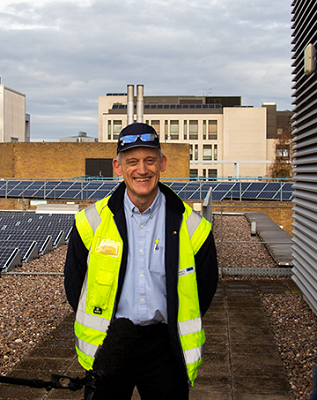The Trust has become the first in the country to use sophisticated technology which chooses between solar, battery and mains energy. This is used to deliver the lowest possible carbon heating and air-conditioning for mums and babies at The Rosie hospital.
It’s led to a 60 per cent carbon reduction1 and represents a major step towards the Trust’s highly ambitious, net-zero carbon future.
Developed by Arriba Technologies on St John’s Innovation Park in Cambridge, the new technology combines photovoltaic (solar) roof panels, cooling, heating and the power of huge lithium batteries with unique computer-controlled electronics in a single unit.
It’s innovative because it can flip between the three different sources of power – sun, batteries and electricity from the national grid – and chooses whichever is the most green at the time.
For example, if there is low demand on the grid it may decide to draw energy from the mains supply, a proportion of which is renewable, allowing the sun’s energy to recharge the batteries ready for the night time.
Or, if the batteries are fully charged and the sun is shining, it would choose to power the unit directly from the sun.
Richard Hales, Energy and Sustainability Manager at CUH (pictured), says: "We are trying to make sure we squeeze every bit of value out of low carbon kilowatt hours. This direct connection and clever power management between PV panels, batteries, mains supplies and heating/cooling plant hasn’t been done anywhere quite like this before, as far as we’re aware."
Maintaining the right temperature at the Rosie Hospital is vital for the welfare of mums and babies. Water has to be heated to high temperatures to ensure it is safely pasteurised. But the environment also has to be cool enough to be safe for patients and provide valued air conditioning on hotter days.
The new system is one of many measures being adopted by CUH in its ambition to halve its carbon emissions over the next 10 years and become net-zero carbon by 2045.
Richard added: “Being a 24/7 major acute hospital means CUH is a very intense consumer of energy, water, goods and materials.
“Front-line patient care, and all the associated support functions and campus infrastructure mean that each day CUH consumes the same amount of gas and water as a small town, and three times as much electricity.
“Our plan is to keep refining the technology whilst replicating and scaling up across our buildings in order to decarbonise our estate. For the past decade the Trust has had a rolling fund to reinvest energy savings in green infrastructure. This has allowed us (together with the decarbonisation of the national grid) to lower our on-site building carbon footprint – even though demands on the hospital have grown.
“We have made significant progress in the more conventional energy efficiency areas of lighting, heating and control systems. Our overall ambition is to become net-zero carbon by 2045, with a very challenging interim target of halving emissions in the next 10 years.”
As well as working to lower the carbon emissions from its existing estate, the Trust is pushing exceptionally hard with the plans for its new buildings, such as the Cambridge Children’s Hospital and the Cambridge Cancer Research Hospital. Both will meet the requirements of the NHS’s new Net-Zero Carbon Building Standard and the principles of Passivhaus design.
1 When compared to the previous conventional chiller unit
Watch a video and read about other measures adopted by the Trust to date
